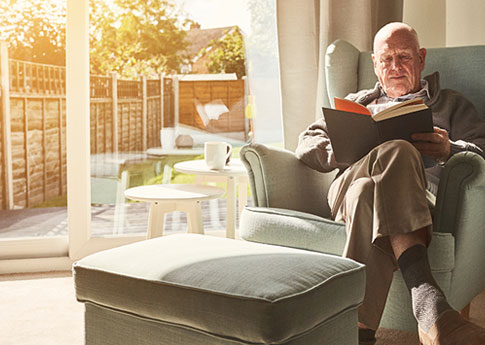Adapting your home to age safely in place

The vast majority of Canadians 60 and over want to stay in their homes and remain independent as long as possible as they age.
To make that wish a reality, you may need to make some adjustments to ensure your home meets your future needs. Just like retirement, aging well at home takes planning. Here are some tweaks and renovations that will make your golden years smoother and more enjoyable.
Reworking the kitchen, bathroom, and bedroom
The concept of home adaptations for seniors immediately brings to mind ramps and handrails in the shower, next to the toilet, by the bed, and along steps and staircases.
But more extensive renovations can maximize your comfort as you age. In the kitchen, for example, installing adjustable countertops and work surfaces can greatly improve your quality of life. And why not get a single-lever or motion-sensing faucet to give your wrists a break?
When renovating your bathroom, consider installing non-slip flooring and mats. Make sure the shower threshold is flush with the floor (walk-in) or has a low edge, and install a seat. You could replace your bathtub with one that has a low rim or a door. You can easily install a raised toilet seat to make standing up easier or if your mobility is reduced. The toilet seat height can be adjusted, and some even come with armrests.
In your bedroom, consider getting an articulated bed with adjustable height and tilt. Besides improving blood circulation and posture, this type of bed makes it easier to get in and out of bed.
Don’t hesitate to consult with accessibility specialists—such as occupational therapists—for advice on modifying your home. CAA-Quebec’s Residential Advisory Services can also answer your questions, provide information on the tax credits and subsidies available for certain renovations, and help you find a reliable company to carry out the work, if needed.

Ensuring proper lighting and brightness for safety at home
Proper lighting in all spaces is key—especially in high-traffic areas like hallways and stairs—to ensuring good visibility and prevent falls. We recommend installing additional light sources, adjusting light intensity and direction, and positioning switches within easy reach. Consider LED light bulbs, which last longer and need to be replaced less often.
Using smart systems, home automation, and other technology
Automated or smart home automation systems can make your life a lot easier and your home safer. Here are some examples of connected devices you may find useful:
Smart thermostats
Programmable voice-activated or motion-sensing lighting systems (indoor and outdoor)
Doorbell with built-in surveillance camera
Smart or digital door locks
Fall detectors
These systems are both reassuring and easy to use, and they’re designed to keep seniors safer at home.
Creating a safe outdoor space
Preventing falls at home
The risk of falling increases as you get older, because balance usually gets poorer, eyesight declines, and muscles aren’t as strong. Unfortunately, most falls happen at home. To minimize the risks, you can make modifications and adjustments to your home to make it safer.
Examples include:
Widening high-traffic areas
Replacing original door hinges with wide-clearance hinges to allow a wheelchair or walker to pass through
Installing sliding or folding doors
Eliminating door thresholds
Replacing door handles with ones that are ergonomic and less likely to catch on something
Removing carpet and rugs, or any other obstacles that might trip you
Reducing the amount of furniture
Because anyone can fall, learn what to do if you fall at home.
By planning this stage of your life carefully, making informed decisions, and setting up your home properly, you can enjoy greater autonomy and live comfortably and safely at home for as long as possible as you age.

Benefit from personalized advice
Do you have questions about your home, need specific information, or are you looking for referrals to find an Approved Supplier?
